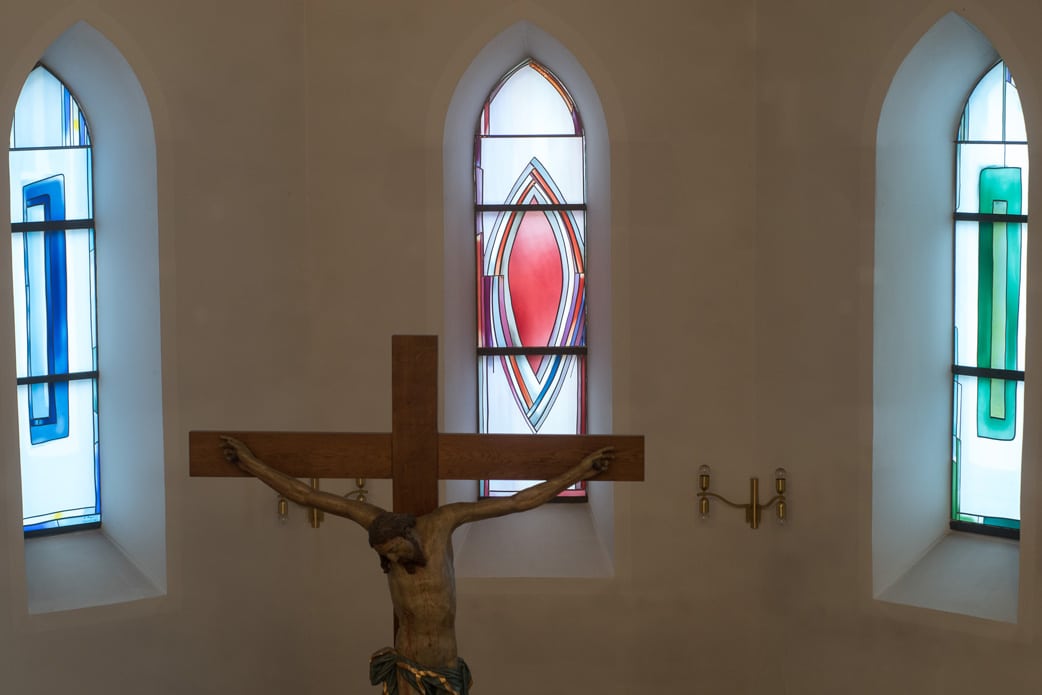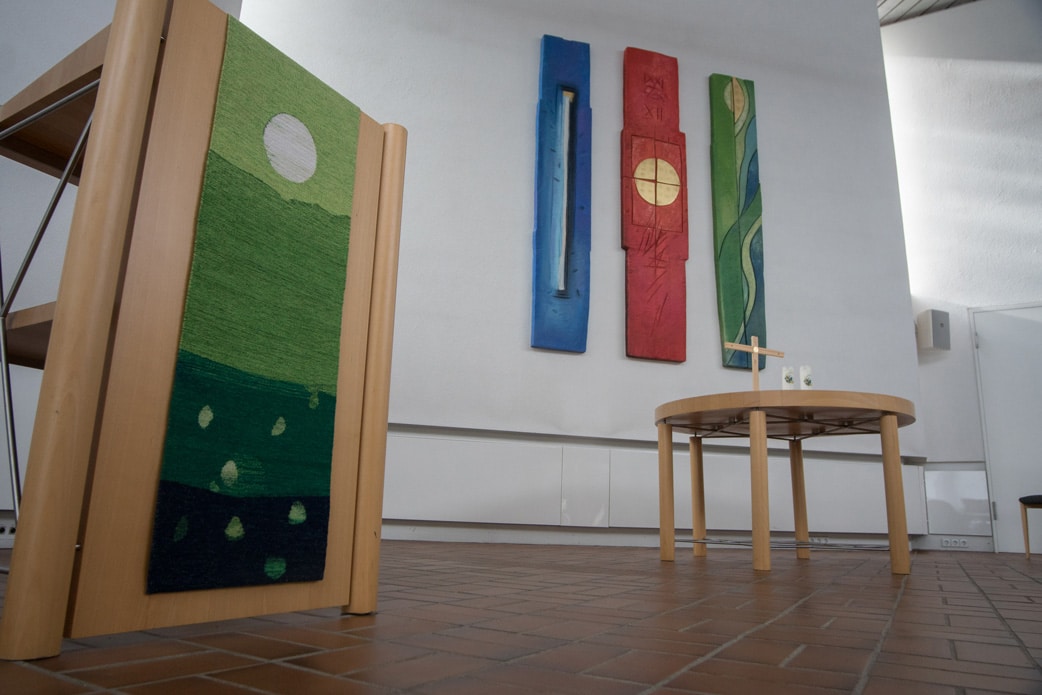
Faith, love and hope, the Christian cardinal virtues, reach far beyond the individual human being. They can create a spiritual connection between the earthly and heavenly worlds – a task that is also fulfilled inside church interiors by the windows that tower far above the viewer. The colours of the stained glass windows receive their radiance from natural light, which in turn is formed pictorially by falling through the windows.
Light and the content of the work enter into a direct synthesis between nature and art: The one speaks through the other. Andreas Felger’s symbolism of colour and form should be comprehensible to every churchgoer: The triad of blue, red and green corresponds to the ecclesiastical tradition of representation for the triad of faith, love and hope. The shapes, high rectangle and oval, take up the respective architecturally given window shape, so that building and work of art become one. This is emphasised by the arrangement of the rectangles in the outer windows, which refers to the symmetrical placement of the window surrounds.
Thematically, this glass work by Felger coincides with the wooden reliefs of the same name in the Primus Truber parish house in Tübingen-Derendingen, but the characteristics of the media and their spatial effect are contrasting. The solid wooden panels stand out and come into contact with the viewer; they mediate between wall and sculpture with material presence and display a high intensity of colour. The Nürtingen glass windows, on the other hand, have an immaterial effect: their architecturally framed, colour-penetrated light-space emphasises the transcendent in love, faith and hope.
Author: Marvin Altner

Three wooden reliefs by Andreas Felger hang on a central wall of the Primus Truber Parish House – towering high and defining the room in their colourfulness. An elementary artistic form stands for the elementary, divine virtues – faith, love and hope. The three panels correspond to each other in material, treatment and luminous colour effect, as if they were parts of a single trunk. They are arranged like a triptych with a larger central section and symmetrical side wings.
The symbol of love is preeminent in the centre and can thus be read as a direct reference to the First Letter to the Corinthians: “For now abideth faith, hope, love, these three; but greatest of these is love”. (1 Cor 13:13 EU) Each of the virtues is represented in a different vocabulary of forms. Hope is referred to by the dynamics of the lines of natural growth and flow of life. Faith is shown as a narrow rectangle, which (according to the artist) refers to the fact that Christian faith only finds its way through the door of Jesus Christ: “I am the door”.
Love is depicted in the form of a cross inscribed in a golden circle. The solid woods have irregular edges, heels and indentations that relativise the symmetry of the composition. The many carvings make the viewer think of the cross of Christian martyrdom. Andreas Felger’s relief work thus corresponds with the small light cross on the altar table, which, with its notches, a divided oval shape and a golden circle, takes up the pictorial symbols of faith, love and hope again.
Author: Marvin Altner

The lead rods of the stained glass window Bread Aggrandizement lie like a net in the composition of fish and loaves, water and light. Seen from the bottom to the top, the depiction becomes successively brighter: it begins with a deep blue and thins out towards the centre of the picture into ochre colours that merge with the white of pure glass light in the sky. The colours of the sun’s edges correspond with those of the round loaves. It is natural to think that the grain they are made of has grown with the power of the sun and that bread and sun alike give man energy to live.
The separation of the upper and lower halves of the picture into the elements of water and air is suspended by the sun, which is shifted to the right. From it, a line of light leads in a slight zigzag down to the fish, so far that it is no longer possible to distinguish between light and the reflecting body of the fish. Compositionally, a cross shape is created in the centre of the work, which is embedded in the multi-layered world of figures and therefore only becomes apparent at second glance. The more closely the viewer follows the lines, the more references he will be able to discern between the individual glass forms and the pictorial objects as a whole.
Jesus’ miracle of the bread aggrandizement, which fed thousands at the Sea of Galilee, can be thought of together with a work of glass art that gives more to see the longer one looks. It thus refers to the believer whose faith can grow the longer it lasts.
Author: Marvin Altner
